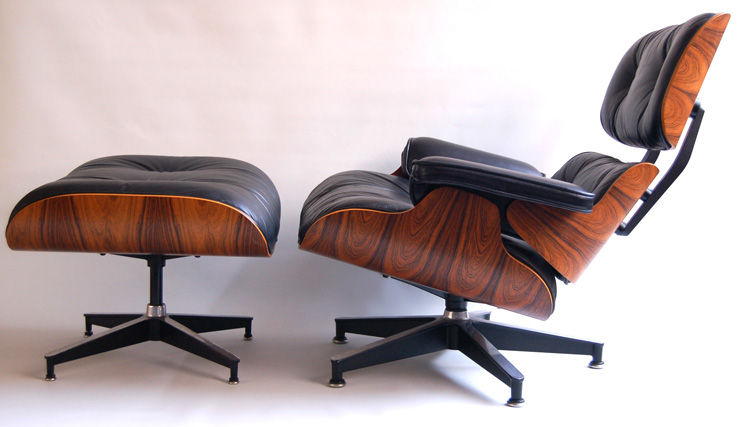
With proper care and maintenance the finish of your vintage furniture will have definite longevity. The below information does not constitute a guarantee of results, it is provided here as a service.
![]()
Oiled Wood
All Modern Conscience furniture is handmade and finished with several coats of hand rubbed tung oil.
For normal cleaning, dust furniture daily with a slightly damp, soft, lint-free cloth. Wipe dry with a dry, soft cloth in the direction of the wood grain. Never use aerosol-powered cleaners (Pledge, Endust), polishes, abrasive cleaners, or oily polishes.
To oil wood parts, prepare the product prior to applying the oil: Rub the entire surface with No. 000 steel wool in the direction of the grain to remove small surface mars, light scratches, and any build-up from previous oiling. Improve the appearance of deep scratches nicks, by sanding the wood veneer lightly with no. 400 grit sandpaper in the direction of the grain. Use caution on veneered surfaces to avoid sanding through the veneer. Apply small amount of tung oil to a clean, soft, cotton cloth. Wipe small sections at a time in direction of grain using a circular motion until the entire veneer is coated. Be sure to apply oil to all exposed edges.
NOTE: Only apply oil on wood and veneer surfaces. Immediately wipe off any oil that makes contacts with leather, plastic, or metal parts. Wipe off excess oil with a clean, soft, dry cotton cloth and smooth in the direction of the grain.
Within 10 minutes, rub again with a soft dry, clean cloth until the entire surface is dry. After about three hours, polish with a soft dry, clean cloth. Allow the oil to dry for 72 hours before sitting in it to avoid transfer to clothing.
As the oil builds over time, the period between applications will extend. Only apply oil when the product looks dry.
NOTE: Properly dispose of rags used with oil as they can accidentally combust. Rinse oily rags with water and hang over a line to allow air to get to all fibers.
Wood
For normal cleaning, dust furniture daily with a slightly damp, soft, lint-free cloth. Wipe dry with a dry, soft cloth in the direction of the wood grain.
Once a month, clean the surface with a soft cloth dampened with a quality cleaner formulated for wood furniture. Wipe the surface in the direction of the wood grain to remove dirt and fingerprints. Wipe dry with a clean, dry cloth.
Twice a year, apply a good quality emulsion wax with a soft cloth. Emulsion wax is clear and prevents fingerprints.
For minor repair of water rings, stains, and scratches, rub the surface lightly in the direction
of the wood grain using No. 000 steel wool. Apply a scratch-removing polish with a color and value that simulate the veneer. If the scratches are deep, please contact us.
Plastic and Fiberglass
For normal cleaning, wash plastic and fiberglass surfaces with a soft cloth soaked in mild detergent and warm water. Rinse thoroughly and dry with a soft cloth. Do not use solvents or abrasive
kitchen cleaners. For a deeper cleaning use Modern Conscience fiberglass cleaning sponges. Apply emulsion wax to fiberglass when the gel coat appears dry or abraded.
Leather
For normal cleaning, vacuum or dust frequently with a clean, dry cloth. If leather is soiled, it can be wiped with a soft, damp cloth using a lather of any mild soap with lukewarm water.
Do not spot clean leather; clean the entire surface. Wipe clean with a damp cloth and dry with a clean, soft cloth.
For spots and spills, wipe excess liquid immediately with a clean cloth or sponge; let the leather air dry. If further cleaning is necessary, sponge the entire surface—seat, back, or chair arm—with lukewarm water. Let the leather air dry; never use a hair dryer or other heat source to dry leather. For stubborn spots and stains, apply a mild, nonabrasive soap solution with a clean, wet sponge. Rinse well and let air dry.
For butter, oil, or grease, wipe the leather with a clean, dry cloth and let the remainder of the oil dissipate into the leather. Do not apply water or try to wash a grease spot.
Do not use saddle soap, cleaning solvents, oils, furniture polishes, varnishes, abrasive cleaners, detergents, or ammonia on leather; they will ruin the finish, causing it to become sticky and cracked.
Polished Aluminum
For normal cleaning, apply a pre-softened paste wax to polished aluminum components
following the manufacturer’s instructions. In humid atmospheres near salt water, apply the wax once a month. In other areas, apply wax every three months to maintain the appearance of the aluminum.
Laminates
For normal cleaning, wash the laminate with a soft cloth and a solution of mild detergent and warm water. Rinse thoroughly and dry with a soft cloth. For minor repair of burns or other stubborn marks, apply a nonabrasive liquid kitchen cleanser with a soft cloth soaked in warm water. Rub in the direction of the grain; use caution to avoid damaging the surface texture or gloss. If no grain direction is visible, rub with a light, circular motion.
Do not use powdered abrasives or other harsh cleansers like hypochlorite bleach, hydrogen
peroxide, nitric or hydrochloric acids, or lye; they may deface the surface and change the
finish color.
Stone
For normal cleaning, wash with a soft cloth and a mixture of a mild detergent and warm water. Rinse with warm water, and wipe dry with a clean, soft cloth. Rinse the tabletop with warm water to remove surface dirt and wipe dry with a clean, soft cloth for routine maintenance.
Acid-based liquids, such as coffee, wine, and fruit juice, need to be wiped up immediately using a clean, soft cloth. The longer a spill remains, the more difficult it will be to remove and may stain.
Do not use abrasive, acid, alcohol-based, or solvent-based cleaners, they will damage the surface.